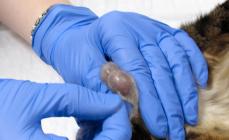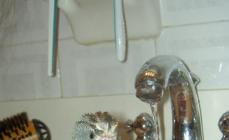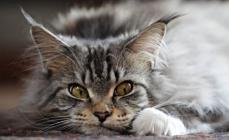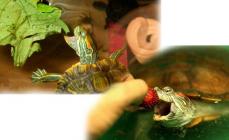Everyone has probably heard at least once in their life that in Ancient Egypt cats were revered like deities. They were respected and considered sacred animals, and archaeologists continue to find statues and images of cats on various valuable objects. According to historians, on the day when one of the cats that lived in the pharaoh's palace died, seventy days of mourning was declared, and the pharaoh himself cut off his eyebrows as a sign of respect. Moreover, mummies of these animals were found more than once during excavations of ancient pyramids. It is believed that cats were the guides of the pharaohs to the kingdom of the dead. Many of you have probably seen mummified animals in the Egyptian Hall of the Museum of Art History. A.S. Pushkin in Moscow.
Having become accustomed to perceiving all this as a historical fact, do we ask ourselves the question - why is this so? As a result of what and for what reasons did the Egyptians have such love and respect for cats?
Cats appeared in Egypt around 2000 BC, while these animals were domesticated about nine and a half years ago. For starters, Egyptians valued cats for protecting them from small rodents, and thanks to rat hunting, cats gained even more respect. By destroying snakes, cats made the area safer to live in. In addition, cats were admired for their gentleness, independence and grace. Residents fell in love with cats very much. For killing an animal you could be sentenced to death.
For the first time in world history, it was in Egypt that cats were endowed with sacred and divine qualities. In some images, the god Ra (the sun god) was a red cat who every day absorbs Apophis, personifying evil and darkness. At the same time, Bast, the goddess of love, beauty, fertility, hearth and cats, was depicted as a woman with the head of a cat. It is with the goddess Bast that cats began to be mummified: Bast was personified by cats, and the honors that they received posthumously indicated why cats were worthy of these honors.
For the sake of cats, the Egyptians were ready to perform heroic deeds. For example, it happened that people rushed into burning houses to make sure that there was not a single cat in the room. This once again proves how respectful, reverent, loving and serious people were towards cats in Ancient Egypt. These were not simply domesticated animals that were aesthetically pleasing and arousing affection. These were helpers and even protectors. But is it really only this help to people, which is described above, that is the main reason for such an attitude towards these animals? Did their involuntary and unconscious help to man lead to an entire cult? Alas, we will never know the exact and complete answer.
The cult of cats reached its serious development at the religious level and its heyday in 1550-1069. BC. It was during this period that the city of Bubastis was created, which became the main place of worship for Bast.
At the end of the 300s AD, the cult of cats was officially banned. So the previous attitude towards cats and interest in them turned into a love for these animals only as pets that were kept at home, and into the spread of this phenomenon in Egypt and beyond.
For several centuries, archaeologists have found cave paintings, vases, and figurines depicting cats in Egypt. And this may already be a sign that even in ancient times the Egyptians revered and respected these animals. Cats in Ancient Egypt were decorated, given various gifts and worshiped. According to scientists and according to documents that have survived to this day, cats occupied a special place in the history of the peoples inhabiting the Nile Valley. It was in Egypt that the cat was first tamed and domesticated. The pharaohs treated cats that lived in palaces with even more reverence. On the day the cat died, the pharaohs went into seventy days of mourning. Why did the Egyptians fall in love with cats? There are several versions.
Excellent rodent fighter
The most basic and widespread food product in Ancient Egypt were various cereals (barley, wheat). Rodents were a real disaster for people. Even a small population of mice could destroy all a family's grain reserves, thereby dooming the family to starvation. The Egyptians needed to preserve their crops, and cats could be the best protectors. Cats could also be good hunters, catching not only rodents, but also birds, which also caused great damage to crops.
Features of the religion of Ancient Egypt
Initially, before the formation of religion with the Pantheon of Gods, there was a Cult of Animals in Egypt. People worshiped various animals and revered them for their power and strength. The Egyptians simply adored cats. They worshiped this animal so much that they practically made them gods. The cat's glowing eyes in the dark made the ancient Egyptians feel trembling fear. The ability of a cat to appear silently and disappear just as silently evoked respect mixed with horror, attributing it to magical properties available only to the Gods. The Egyptians admired these soft and furry creatures. There is evidence in historical literature that when a Roman cart driver accidentally ran over a sacred animal, he was immediately killed by an angry crowd that attacked him. If a cat was killed by someone in Egypt, it was considered a terrible crime and was punishable by death. Also, on pain of death, the export of cats from the country was prohibited.

goddess Bastet
It was in Egypt that cats were given various gifts. There are many examples of this: the god Ra was depicted as a red cat. The ruler of the hearth, female beauty and fertility, the goddess Bastet (Bast) was depicted as a woman with the face of a cat. In honor of this cat goddess, temples were built and annual holidays were held, and the priests made sacrifices both to the goddess Bastet and to the cats who lived at the temples. The cat was loved for its cleanliness and immense care for its offspring. And these properties were also attributed to the goddess Bastet.
If there was a fire in the house, people would rush into the fire to make sure that there were no cats left there. Dead cats were mummified and buried with special honors, and the family shaved off their eyebrows as a sign of grief. The cult of Bastet was officially banned by Pharaonic decree in 390 AD. Thus, religious interest in cats began to wane in Egypt, and although they remained as pets, they were no longer objects of worship in temples.
Love played a cruel joke
But such a great love for cats once turned out to be a different side for the Egyptians. In 525 BC. Egypt was attacked by the Persians. The Persian king, Cambyses II, decided on an insidious, vile cunning. Using knowledge of the great love and religiosity of the Egyptians for cats, he ordered his warriors to attach cats to their shields. Thus, the Egyptians faced a difficult choice - break the law and kill the sacred animal or surrender with virtually no fight. In the end, we chose the second one. Thus, Cambyses II, thanks to his sophisticated cruelty and knowledge of the laws of another country, was able to conquer Egypt.
Only wealthy people could keep a cat in their home, since the cat required special care, which was not very cheap. Cats didn't just eat mice. The cats were given the best pieces of meat or fish.
Cats in Egypt today
 Cats and people have lived together for more than 6,000 years. Despite this, unlike other domestic animals (cows, horses, dogs), the cat managed to maintain its primitive independence and free character. Today, in Egypt, the cat is as common a pet as in many other countries. Some people are avid cat lovers, while others can’t stand these fluffy creatures. But, nevertheless, living under one roof for such a long time could not help but leave its mark on the behavior of both people and cats. As before, they try not to offend cats (so as not to incur the wrath of the Gods). Man constantly uses cat motifs in his creativity, be it fine art, sculpture or cinema. Love and respect for cats seems to be already in the Egyptians' genes.
Cats and people have lived together for more than 6,000 years. Despite this, unlike other domestic animals (cows, horses, dogs), the cat managed to maintain its primitive independence and free character. Today, in Egypt, the cat is as common a pet as in many other countries. Some people are avid cat lovers, while others can’t stand these fluffy creatures. But, nevertheless, living under one roof for such a long time could not help but leave its mark on the behavior of both people and cats. As before, they try not to offend cats (so as not to incur the wrath of the Gods). Man constantly uses cat motifs in his creativity, be it fine art, sculpture or cinema. Love and respect for cats seems to be already in the Egyptians' genes.
The Sphynx is Egypt's most famous cat
The Sphinx is a mythical creature with the body of a lion (a member of the cat family) and the head of a man, falcon or ram. The word itself is of Greek origin and is translated as “strangler.” The ancient Egyptian name of this creature could not be established. Such statues personified the pharaoh defeating his enemies. The statue of sphinxes was installed in temples and near burial vaults. The most famous Great Sphinx - one of the oldest sculptures on Earth - is located in Giza, on the west bank of the Nile, near the Pyramid of Cheops. 
Currently, there is also a breed of Sphynx cats, which in turn is divided into:
— Canadian Sphynx;
— Petersburg Sphynx or Peterbald.
The ancient Egyptian inscription on the obelisk in Nebra reads: “Oh, wonderful cat, bestowed forever.” The cult of this small predator began during the Old Kingdom and lasted for many centuries. Never in any state in the world has this graceful animal been revered as much as in the country of the pyramids. Cats in Ancient Egypt were not only full members of Egyptian families and favorite pets of the pharaohs, people assigned them divine status and built temples and even entire cities in their honor. It was a golden age in cat history.
The role of the cat in Ancient Egypt: why were these animals deified?
Ancient Egyptian cat figurines
The past of Ancient Egypt and the history of the domestication of wild cats are inextricably linked, since it was in the land of the pyramids that the ancestors of modern cats first began to live next to humans. This is evidenced by many sources dating back to the 3rd millennium BC.
Even then, on the paintings in the tombs of noble citizens and even the pharaoh himself, furry animals were depicted living in the house as honorary family members and wearing special collars. Egyptian artists tried to paint the sacred animal in any form and pose on funerary slabs or papyri. Sculptors sculpted them from gold, bronze, stone or wood, sculpted them from clay, and carved them from elephant tusks. Young Egyptian women always kept amulets with cat images, which were called “uchat” and were a symbol of childbirth.
Thanks to frescoes and other objects of art decorated with graceful feline figurines, it also became known that the Egyptians called their pets "miu" or "miut". There is an assumption that cats received this nickname because of the meowing sounds they make. This name was also given to girls to emphasize their beauty, grace and softness.
The inhabitants of the country of the pyramids greatly revered furry animals. They admired their cleanliness and grace. A special mystery for humans was the secret twilight lifestyle of the cat, its eyes glowing in the dark, silent gait, and independent disposition. These unusual and inexplicable qualities awed the ancient people and instilled in their hearts boundless respect for the freedom-loving animal. In addition, the cat was also credited with mystical abilities - according to the Egyptians, it could visit the other world.
Therefore, cats were welcome guests in many temple complexes of Ancient Egypt. There they were fed fresh fish, which were specially bred in ponds. The care of temple animals was carried out by priests - “cat guardians” and was one of the most honorable services in the state. Moreover, this respected profession was proudly passed down from father to children. Superstitious Egyptians believed that temple animals were able to predict the future. Therefore, the priests carefully watched their every gesture, and then interpreted the signs, believing that this was how the gods themselves communicated with them.

The practical side of the issue
The veneration of cats in Ancient Egypt also had economic prerequisites, in addition to mystical ones. In those distant times, the state was engaged exclusively in agricultural activities and was famous throughout the world for its rich harvest of grain crops. In fact, the life of the country of the pyramids directly depended on the amount of wheat grown and its safety.
But the harvest was often completely destroyed by countless hordes of rodents. It was then that the ancient Egyptians paid attention to furry animals, each of which was able to save up to ten tons of grain a year. Thus, cats were vital animals for the survival of an entire nation.
Small predators also deftly destroyed poisonous horned vipers, of which there were great numbers in those lands. Cats were also taken for hunting as game animals; they caught birds and fish.
Thanks to the cat mummies that have survived to this day, archaeologists and scientists were able to find out what these animals looked like in those distant times. They were small in size, thin, graceful and mostly a solid reddish color.

The meaning of the goddess Bastet in religious cult

Archaeologists suggest that the ancient Egyptian pantheon contained the names of several hundred gods. But one of the most popular deities included in the “sacred nine” (nine supreme deities) was considered a young and beautiful girl with the head of a cat - the goddess Bastet (Bast).
Her statues were carved from stone and made of gold or bronze. In her hands she held a sistrum (musical instrument), and four kittens frolicked at the feet of the goddess. On the bases of these statues and obelisks were carved sacred prayers: “I am the cat, the mother of life. She can give life and strength, all health and joy of the heart.”
The cats of Egypt were also revered in two guises: the Sun God himself was often depicted in the form of a red cat (the male form of Bastet). And in the ancient Egyptian Book of the Dead, the Great Matu is depicted - a white cat who saved humanity from the serpent Apophis.
Sometimes the goddess was depicted with a lion's head to emphasize the duality of nature. This is connected with one interesting legend about the daughter of the supreme god Ra, who could take the form of a lioness - Sekhmed (or Muut). She was the mistress of the desert, the formidable and merciless goddess of war and the scorching sun. As weapons she had the sultry winds of the simoom and arrows that struck enemies to the very heart.
Despite her quarrelsome character, Sekhmed was considered the guardian of peace and protector of the human race. Thousands of believers offered prayers to her in moments of danger and asked for protection from ill-wishers.

According to the myth, Ra sent Muut to earth to punish disobedient people. But once she got to mere mortals, the cruel goddess tasted human blood, went mad and crossed all permitted boundaries. She began to mercilessly exterminate humanity. Then the god Onuris decided to deceive the lioness and doused the ground with beer tinted red (according to another version, red wine).
Mistaking the drink for blood, she began to lap it up and soon became drunk. It was then that the gods turned the bloodthirsty wild animal into a fluffy miniature cat. Therefore, in addition to the refined cat essence, Bast also had a second dark nature of the cruel predator Sekhmed. Over time, this myth was forgotten, and after 2000 BC, images of Bastet changed significantly - she began to be depicted exclusively in the form of a graceful cat.
In the country of the pyramids, Bast personified life itself, the fertility of women and the earth, and was the patroness of the hearth and protector of the pharaoh and his family. In addition, the royal goddess was associated with sunlight and moonlight. She was given the power to open the dawn of a new morning.
Also, the cat goddess was revered as the patroness of pregnant and giving birth girls, since these are the animals that kitten easily. The ancient Egyptians believed that Bast protected children from the bites of poisonous snakes and scorpions, as well as serious illnesses. Therefore, amulets with the image of a cat were made for newborns, and corresponding tattoos were applied to older children.

Temples built in honor of the cat-headed woman
In the religion of Ancient Egypt, the divine cat had great significance and influence. In her honor, not far from the Nile Delta, a religious center of worship was built - the city of Bubastis, in which there was a beautiful temple dedicated to the cat goddess, according to the description of the ancient Greek historian Herodotus. It was here that annual religious celebrations associated with the cat cult took place, where many pilgrims flocked from all over the country. Archaeologists even found the largest burial of mummified furry animals (about three hundred thousand mummies) in the ancient city.
It is also known that in the temple complex of Saqqara, not far from the step pyramid of Djoserra, the Egyptians erected a large sanctuary in honor of the cat. In its center stood a gigantic statue of Bastet, made of expensive Aswan marble. During religious celebrations, the statue was taken out of the temple, loaded into a boat and transported along the river banks.
Historians associate such a rise of the cat-headed goddess with serious political changes in the country of the pyramids, when central power moved from the Upper Kingdom to the Lower Kingdom, and the state had a new capital - Per-Bast (house of Bast). The cult of Bastet lasted on Egyptian soil until the 4th century AD.
Little known facts
The descendants of the sacred Nubian cats are the modern Egyptian Mau, which became famous throughout the world thanks to its natural leopard color. There is also a version that the first cats of the country of the pyramids were descendants of reed and steppe cats. Hairless animals, the sphinxes, also played a special role at the pharaoh's court, which eventually disappeared from Egypt and were revived to life in Canada only in the 70s of the 20th century.
Interesting facts about ancient Egyptian cats, which only emphasize their importance for the inhabitants of the country of the pyramids:
- Almost all ordinary Egyptians had their own furry favorite. They left fresh fish for her as a treat, looked after her as the most honorable member of the family, and believed that for this she would protect all the residents of the house. If a fire suddenly started, the pet was taken out of the burning building first and only then the children.
- The Egyptians protected the sacred cat and prevented its export outside the country, since the animal was the property of the pharaoh himself. Violation of this rule was punishable by death, and animals that left the state were returned home through ransom or kidnapping.
- Even for the unintentional murder of the little rat catcher, the criminal paid with his own life. The Greek historian Diodorus Siculus testified to the case of how one of the Romans accidentally drove over an animal in a chariot and was torn to pieces by angry Egyptians for this.
- If a furry pet died, her funeral was held with great honors and funeral songs, and the owners shaved off their eyebrows and hair on their heads in tribute and plunged into a long 70-day mourning.
Dead animals were mummified by being wrapped in linen cloth with ornaments and sacred prayers and anointing the body with incense and oils. It was believed that thanks to this ritual, the pet’s soul would gain the ability to be reborn in a new body. Rich citizens put a gold mask on the mummy, placed it in a wooden, bronze or gold sarcophagus and left their favorite toys and embalmed mouse carcasses in the tomb.

Photo of a cat mummy exhibited in the Louvre
But the worship of the furry pet once played a cruel joke on the Egyptians. According to the records of the historian Ptolemy, in 525 BC. cats negatively influenced the results of the siege of the border city of Pelusium by Persian troops. Circumstances forced the Persians to stand under the walls, since they were not known for their ability to storm well-defended cities.
Then King Cambyses II ordered to catch many cats and tie them to the armor and shields of the soldiers walking in front of the entire army. Seeing this, the Egyptians did not dare to use spears and arrows, so as not to injure any sacred animal. As a result, the battle was lost. But despite everything, cats continued to be deified in Egypt until the conquest of the country by the Greeks, and a little later by the Roman legions.
The ancient Egyptians endowed cats with magical properties and considered them sacred animals. This is evidenced by numerous archaeological finds, which include statues of cats decorated with crowns and necklaces, as well as antique vases with their images. Cats were treated as some kind of deities. They were revered, dressed in expensive clothes, and made offerings.
The cats that lived in the chambers of the pharaohs were especially respected. During their lifetime they were deified, and in case of death they declared a week of mourning. In addition, on the day of the death of his beloved cat, the pharaoh cut off his eyebrows, which was a sign of great sorrow for the deceased animal. The exact opposite ritual was carried out in the event of the death of the pharaoh himself. In a tomb built in a pyramid, next to the deceased owner, they placed his favorite cat, which was previously killed and mummified. In their opinion, she was supposed to accompany the pharaoh to the next world.
And yet, what is the reason for this attitude of Egyptians towards cats? Why were their images painted on the tombs of the pharaohs, and even temples were built in their honor?
According to scientists, wild cats were domesticated by the Egyptians around 1900 BC. These animals protected people from small rodents, and did not require special care. They were easily tamed, obeyed their owners in everything, and led a carefree life. Cats became especially popular during the plague epidemic, which was carried by rats. They mercilessly destroyed them, making human life safer.
It is believed that it was thanks to the ability of cats to destroy rats and small rodents that they became so revered by people. They were not just loved, but deified. Killing a cat was considered the greatest sin and was punishable by death.
According to the ancient Egyptians, cats were sent to earth by the Gods to protect people. This is evidenced by the fact that the sun god Ra was depicted in the form of a cat fighting the serpent Apol, who was the personification of evil. Also in Egyptian frescoes we can see an image of a woman with the head of a cat. This is the goddess of love and fertility Bastet. This is exactly how the Egyptians imagined it. In her honor, annual holidays were held, sacrifices were made, and dead cats were embalmed and buried with honor.
But that's not all. Historians claim that in honor of the Goddess Bastet, Pharaoh Shoshenq built an entire city called Bubastis. It was at this time that cats became objects of religious worship. True, this did not last long. In 390 AD, the religious cult of cats was abolished by order of the emperor. Since that time, the attitude towards cats has also changed. They no longer enjoyed special privileges and became just ordinary pets. However, in Egypt they are still loved and respected.
Ancient Egypt was an agrarian civilization, therefore, destroying mice and rats that encroached on their supplies, as well as posing a threat to the life of snakes, was of such value that over time it was elevated to the rank of a sacred animal. Only the pharaoh could consider cats his property, so they were all under his protection and killing any of them was punishable by death. However, for Egyptian legislation there was no difference in whether the cause of death was an accident or intentional acts.According to Herodotus, during a fire, Egyptians had to stand around a burning building to prevent a cat from jumping into the fire. It was believed that the animal could have run into the house to check if there were kittens there.
Everyone tried to lure a furry animal into their home; it was believed that a cat living in the house kept peace and quiet in it. Those who were unable to secure the patronage of the deified animal ordered its figurines made of wood, bronze or gold. The poorest hung papyri in their houses with images of graceful animals.
When a cat died, all household members had to shave off their eyebrows as a sign of deep mourning. The animal was mummified according to all the rules, wrapped in valuable fine linen and the mummy was treated with valuable materials. Cats were buried in special vessels or sarcophagi decorated with gold and precious stones, and everything that was supposed to brighten up their afterlife was also placed there - jugs, dried fish, mice and rats.
Cats and Egyptian gods
The goddess Bast or Bastet - the daughter of the sun god Ra, the wife of the god Ptah and the mother of the lion-headed god Maahes - was depicted as a woman with the head of a cat. She was the patroness of women, children and all domestic animals. Bast was also considered a goddess who protected against infectious diseases and evil spirits. It was she who was revered by the Egyptians as a goddess of fertility. Bast was often depicted with a rattle, this was due to the fact that cats, who gave birth often and in large numbers, as well as tenderly caring for their offspring, were symbols of motherhood.Women who asked the goddess Bast for children wore amulets with images of kittens. The number of kittens per decoration was equal to how many children they wanted to have.
Also, ancient Egyptian cats were considered “the eyes of the god Ra.” This high title was apparently given to them in connection with the peculiarity of the cat’s pupils - in the light they narrow, becoming like a moon, and in the dark they expand, becoming round like the sun. This is exactly how the Egyptians imagined the two eyes of Ra - one solar, the other lunar.





